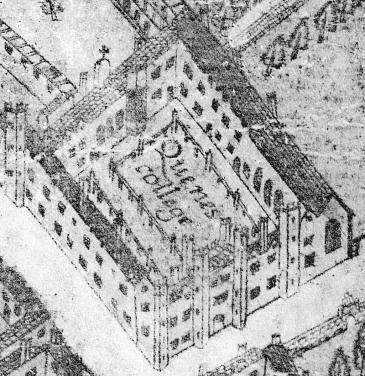Every tourist gets told that the name of Queens’ College is spelled in the plural form with the apostrophe after the final letter ‘s’ because the College was founded by two Queens of England — first in 1448 by Margaret of Anjou (daughter of Duke René of Anjou), wife of King Henry VI of England (the founder of King’s College Cambridge), and secondly in 1465 by Elizabeth Woodville, wife of King Edward IV of England.
But how true can this story about the apostrophe be? It turns out: not much.
First: the use of the apostrophe in English to indicate the possessive is of no great antiquity: it would not have been used in the period after the second foundation of the college, and so the question of the position of the apostrophe would never have arisen at that time. For the first two centuries of its existence, the name of the college was spelled in English without any apostrophe. For example, in John Hamond’s view of Cambridge in 1592, the name was spelled Quenes college.
Even as late as 1655, Thomas Fuller did not use apostrophes in his History of the University of Cambridge, but used the form Queens Colledge.
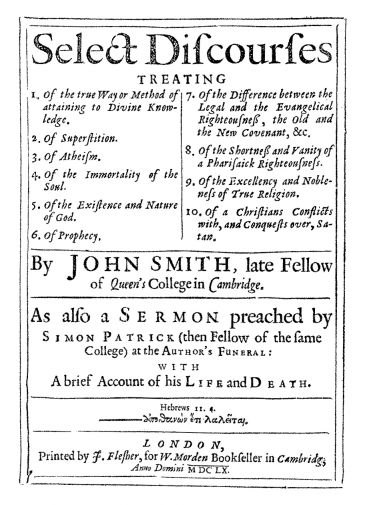 Second: after the apostrophe began to appear in English orthography for the possessive, early examples of the name of the College consistently spelled it in the singular form as Queen’s. The earliest example so far found in print of an apostrophe in the name of the college dates from 1660, in the Select Discourses, of John Smith [Fellow], edited by John Worthington, where the name of the college appeared as Queen’s, with the apostrophe before the ‘s’.
Second: after the apostrophe began to appear in English orthography for the possessive, early examples of the name of the College consistently spelled it in the singular form as Queen’s. The earliest example so far found in print of an apostrophe in the name of the college dates from 1660, in the Select Discourses, of John Smith [Fellow], edited by John Worthington, where the name of the college appeared as Queen’s, with the apostrophe before the ‘s’.
The name remained spelled in the singular form for the next 160 years, at least.
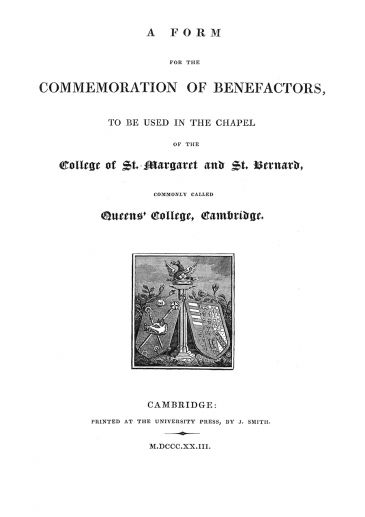
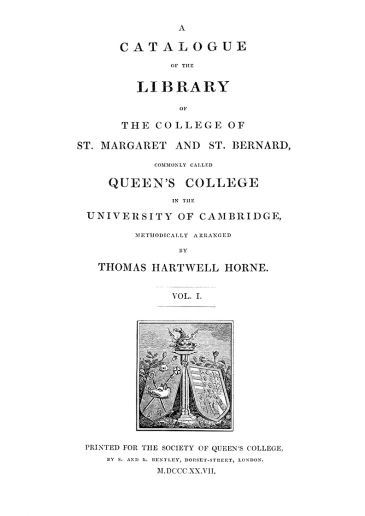 The earliest example so far found of the name of the College spelled in the plural form as Queens’ was in 1823, in the Form of Service for the Commemoration of Benefactors, edited by G.C. Gorham [Fellow]. In this document, the plural spelling Queens’ is used consistently for the name of the college. Yet, only a year earlier, the same editor had used the form Queen’s in his 1822 edition of the college Statutes [p. 76].
The earliest example so far found of the name of the College spelled in the plural form as Queens’ was in 1823, in the Form of Service for the Commemoration of Benefactors, edited by G.C. Gorham [Fellow]. In this document, the plural spelling Queens’ is used consistently for the name of the college. Yet, only a year earlier, the same editor had used the form Queen’s in his 1822 edition of the college Statutes [p. 76].
This appears to have been a one-off reform attempt, as, in 1827, the spelling of the name of the college reverted to the singular form in the Library Catalogue by T.H. Horne.
Elsewhere, outside the college, the singular spelling continued to be used for some years more.
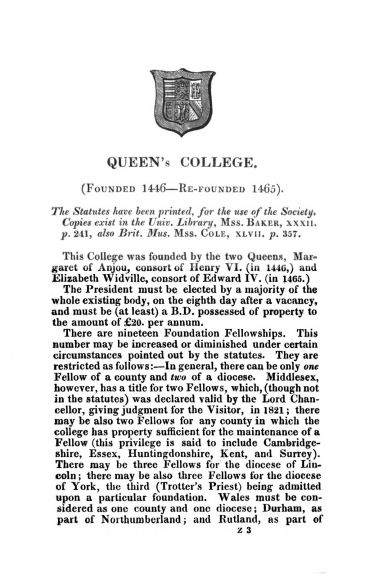
 The spelling changed from Queen’s to Queens’ in the annual Cambridge University Calendar of 1831 and thereafter. You may compare the Calendar of 1830 with the Calendar of 1831.
The spelling changed from Queen’s to Queens’ in the annual Cambridge University Calendar of 1831 and thereafter. You may compare the Calendar of 1830 with the Calendar of 1831.
Left: 1830
Right: 1831
Many guide-books and histories followed this change of spelling during the 1830s.
In the early editions of Le Keux’s Memorials of Cambridge, by Thomas Wright and Harry Longueville Jones, published in part form 1837–1842, the name of the college is spelled Queen’s College, and a footnote is appended:
A custom has arisen latterly of writing the name Queens’ College, as being the foundation of two queens. This appears to us an unnecessary refinement. We have the authority of Erasmus against it, who always calls his college “Collegium Reginæ”.
“Reginæ” is Latin for “of the Queen”, in the singular. Despite this complaint, the change of spelling to Queens’ became well established in the 19th century.
The formal corporate title of the College is now:
The Queen’s College of St Margaret and St Bernard, commonly called Queens’ College, in the University of Cambridge.
which shows both forms of spelling. This is formally correct. The name of the college when qualified by the patron saints is spelled in the singular; the short-form common name is spelled in the plural.
Related spelling issues
Queens’ Lane is named after the College, and should therefore be spelled in the same way.
Queens’ Green is presumably named for its proximity to the College, and should therefore be spelled in the same way. (Queens’ Green is owned by Cambridge City Council, and is registered Common Land). In Loggan’s 1688 plan, it is marked as Queens Coll: Green. In an earlier 1634 publication, this area appears to have the name “Youngs green or bank”.
[The Foundation of the Universitie of Cambridge, by John Scot the Elder, edition of 1634 or later. (OCLC 607140137)]
Queen’s Road is named after Queen Victoria, so is correctly spelled Queen’s in the singular form. The un-named road previously referred to as “the road along the backs of the colleges” or simply “The Backs” was given the name “Queen’s Road” by the Cambridge Improvement Commissioners at their meeting on 1889 June 18.
[Cambridge Independent Press, vol. LXXXIV, No. 3814, 1889 June 21, p. 6 col. 5 - credit to Mike Petty for finding this reference]
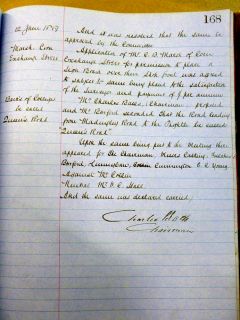 The above decision followed a motion carried at a meeting of their General Purposes Committee on 1889 June 12:
The above decision followed a motion carried at a meeting of their General Purposes Committee on 1889 June 12:
… that the Road leading from Madingley Road to the Pightle be called “Queen’s Road” …
[General Purposes Committee Minute Book 13 August 1885–16 October 1889, p. 168, Cambridgeshire Archives CB/4/3/12]
[At that time, Sidgwick Avenue had not yet been built. Pightle Walk was a narrow footpath from the western end of Silver Street to the north-east corner of Ridley Hall. It was not until 1893 that Pightle Walk was widened into a road and named Sidgwick Avenue, extending from Silver Street westwards to Grange Road. See Cambridge Described and Illustrated, by Atkinson & Clark, 1897, p. 484]
The street name “Queen’s Road” appears in Kelly’s Directory of Cambridgeshire, Norfolk and Suffolk from the 10th edition of 1892 [p. 47 col. 2] onwards, and not in the 9th edition of 1888 and earlier [e.g. 8th ed. 1883 p. 35 col. 3].
The above references disprove certain other published statements about the origin of the name:
Queen’s Road is written with the apostrophe before the s, because it was not named after the college founded by two Queens, but to commemorate Queen Victoria’s Jubilee [1887].
[A House by the River, 1976, by Margaret Elizabeth Keynes née Darwin (1890–1974), p. 1n. (ISBN 978-0-9505198-0-7)]
… QUEEN’S Road, named after she [Queen Victoria] visited Cambridge in 1842 and 1847.
[Cambridge Street-Names : Their Origins and Associations, 2000, by Ronald Douglas Gray (1919–2015) and Derek Stubbings (d. 2009), p. 57. (ISBN 978-0-521-78956-1)]
